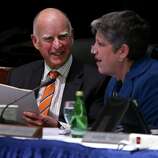UC Berkeley has been overspending by millions of dollars a year since 2013, a precarious course that prompted Chancellor Nick Dirks to announce Wednesday the possibility of layoffs and cuts to intercollegiate athletics to balance the budget.
The campus will also receive a financial infusion from University of California headquarters and will spend the next several months working with UC officials, faculty and the campus’ fundraising foundation to identify cuts and brainstorm ways to attract more cash.
“This is a moment not just to stabilize our finances, but also to consider our future as a leading institution of higher education,” Dirks said in a statement. He said UC Berkeley is operating with a “substantial and growing structural deficit, one that we cannot long sustain.”
UC Berkeley is projecting a deficit of $150 million this fiscal year — about 6 percent of its operating budget of $2.5 billion. The campus overspent by $109 million last year and by $12 million in the 2013-14 fiscal year, according to campus officials. In previous years, despite the economic recession, the campus enjoyed surpluses.
When it comes to cuts, “every aspect of Berkeley’s operations and organizational structure will be under consideration,” Dirks said. Sources said there are no plans to reduce the number of tenured faculty, roughly 1,600 professors.
One area Dirks singled out for possible reductions was intercollegiate athletics. Any attempt to cut the number of sports, however, is sure to be a sensitive subject. When the university tried to eliminate the men’s baseball team in 2011, it prompted an uproar among alumni who eventually helped raise enough money to rescue it.
But intercollegiate sports are also operating at a deep deficit. Campus records show that athletics spent $9 million more than they took in last year, the first time sports reserves were too depleted to fully cover the gap. In 2013-14, athletics overspent by $4 million, and the year before by $2 million.
Officials blame campus-wide deficits on minimal increases in state funding, combined with a four-year UC tuition freeze that they say has hit Berkeley especially hard. They say Berkeley relies more on tuition and fees than do the other nine UC campuses, some of which make money from medical centers. Others get extra support from UC headquarters.
Officials say 42 percent of UC Berkeley’s revenue comes from research funding and philanthropy and must be spent for specified purposes. State funding accounts for 13 percent of the budget, while tuition and fees make up 30 percent. The remaining 15 percent comes from miscellaneous sources.
UC Berkeley officials say the most recent 4 percent increase in state funding doesn’t begin to cover ballooning costs, which come primarily from pension and health care obligations, as well as seismic and infrastructure needs at UC’s oldest campus.
Campus officials began analyzing their financial problems last spring, when UC President Janet Napolitano and Gov. Jerry Brown agreed that the tuition freeze would continue until 2017. After that, tuition is expected to rise by the cost of living.
The campus will spend the next several months deciding what steps to take — including whether layoffs are needed or whether the average departure of about 200 employees a month will be enough to avoid them.
Other changes and new policies are expected to be implemented beginning this summer.
Nanette Asimov is a San Francisco Chronicle staff writer. E-mail: nasimov@sfchronicle.com. Twitter: @NanetteAsimov






